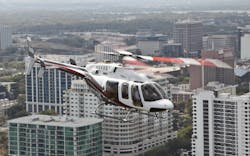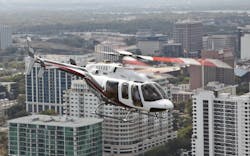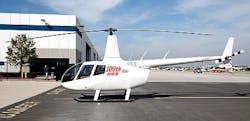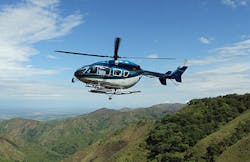Honeywell forecasts increased demand for civil helicopters
LAS VEGAS, 6 March 2013. Honeywell (NYSE:HON) forecasts an increase in civil helicopter deliveries over the next five years, according to its 15th Turbine-Powered Civil Helicopter Purchase Outlook report.
Reasons for Replacement
Operators who indicated the intent to replace a currently owned helicopter with a new one within the next five years cited “age of current aircraft” or “normal planned or contracted replacement cycle” as key drivers for their decision. Once the choice to replace a current helicopter in the fleet or expand operations has been made, the make/model choice is influenced strongly by performance criteria including range, cabin size, reliability and safety, hot/high performance, and brand experience.
Operator Preferences by Class of Helicopter
Light Single-engine helicopters continue to be the most popular product class for five-year fleet replacement and expansion. The most frequently mentioned Light Single models were Eurocopter EC130/AS350 series, Bell 407 and Robinson R66. Light Single helicopters had the highest concentration of regional purchase interest in North America, while purchase interest was lower in Europe, Latin America and Asia. The Middle East and Africa showed a noticeable surge in interest in the Light Single class in 2013 versus earlier surveys.
Intermediate/Medium twin-engine helicopters tied for the second most popular product class mentioned for purchase during the next five years, holding roughly the same market share as in the 2012 Outlook. Approximately 25 percent of total survey mentions were for Medium Twins. The most frequently mentioned models were AW139, AW169, Bell 412, EC145 and Sikorsky S-76 series helicopters. The highest concentrations of demand for Medium Twins were measured in Middle East/Africa, Asia and Latin America. Between 30 percent and 40 percent of all make/model mentions in Asia and Middle East/Africa were for Medium Twins.
The Light Twin helicopter class also garnered 25 percent of total operator purchase plans in the 2013 survey. The EC135, Bell 429 and AW109 series helicopters were most frequently mentioned for five-year purchase in this class. Light Twins appear to be most popular in Europe and to a lesser extent in Asia and the Americas. In Europe, Light Twin models accounted for 37 percent of total mentions.
In the 2013 operator survey Heavy Multi-Engine helicopters declined slightly from 2012 levels. This class of helicopter typically garners a small share of overall purchase plans due to the cost and specialized nature of the aircraft. 2013 saw a 1 point decline in interest for this category of aircraft. Within the Heavy helicopter class the most frequently mentioned models were the EC225, the Mi-171 and the S-92. Various Russian models accounted for more than half of the purchase plans in this class.
The vast majority of global civil helicopter mentions were concentrated in products manufactured by three OEMs: Eurocopter, Bell Helicopter and AgustaWestland. Less than 15 percent of mentions were for helicopters manufactured by all remaining OEMs.
Again in this year’s survey, Honeywell asked all respondents to indicate their “current” satisfaction over the last year with each model of aircraft they operate. Respondents answered the question, “How likely is it that you would recommend this model to a friend or colleague?” Listed in alphabetical order for models receiving over 25 responses, the top six (two models tied for top five) make/models with the highest net scores in this year’s survey are these:
AW139
Bell 206 series
Bell 407
Bell 412
EC130/EC350 series
S-76
These six models account for nearly 50 percent of all survey make/model mentions and can be considered the top current production helicopters in terms of recent customer satisfaction attitudes and likelihood to promote. There were many other make/models currently in production that also received excellent scores that did not make it into the top six listing.
Helicopter Utilization Expected to Increase
Utilization rates reported in this year’s survey for the past 12 months were flat in North America and Europe, but rose in the other regions. Looking ahead for the next 12 months, plans for increased helicopter fleet utilization in 2013 were reported by operators in all regions. Planned increases in each region were as follows:
North America: 10 percent of operators plan increases, and only 3 percent plan decreases.
Europe: 16 percent of operators plan increases, and only 7 percent plan decreases.
Latin America: 27 percent of operators plan increases and only 5 percent plan decreases.
Middle East/Africa: 33 percent of operators plan increases and only 15 percent plan decreases.
Asia: 35 percent of operators plan increases, and only 6 percent plan decreases.
European operators reported the lowest annual average usage rate among the regions; however European operations measured by Eurocontrol flight data did post solid gains in 2012. When examining utilization trends across usage segments, oil and gas was the highest at an annual average of approximately 725 hours per aircraft followed by emergency medical services, tourism, training and general utility closely grouped at approximately 410–430 hours per year. Law enforcement and electronic news gathering came in at 375–390 hours. The lowest average utilization was reported by corporate segment operators at less than 300 hours per helicopter.
Civilian Turbine Helicopter Survey
The 2013 Turbine-Powered Civil Helicopter Purchase Outlook is based on Honeywell’s recently conducted customer expectations survey, an assessment of consensus forecasts, a review of factory delivery rates and analysis of future new helicopter introductions. The 2013 Outlook excludes uniformed military demand for civil helicopters, but resulting civil estimates do include government and security force demand.
Methodology
The 2013 Outlook presents a snapshot of the helicopter business at a point in time and reflects the current business and political environment. This year’s survey queried more than 1,000 chief pilots and flight department managers of companies operating 2,400 turbine and 275 piston helicopters worldwide. The survey excluded large fleet or “mega” operators, which were interviewed separately. Input received from large oil and gas support and EMS fleet operators is factored into the overall outlook in addition to the individual flight department responses. The survey detailed the types of aircraft operated and assessed specific plans to replace or add to the fleet with new aircraft.
The survey does not reflect unforeseen events such as an unexpected economic downturn, the impact of government stimulus programs, sharp increases or decreases in fuel costs, a fuel availability crisis, the imposition of heavy user fees, or other unfavorable regulations or taxes that could affect results in future years. Nor does it include speculation of aircraft manufacturers to offer discounts or raise prices, which can have a significant influence on sales activity of affected models.
NOTE: Ongoing political instability in the Middle East and current slow economic growth projections for Western economies in the near term was factored into the current survey and forecast results. Demand for civil rotorcraft is also potentially sensitive to fuel price volatility and possible supply disruptions.



